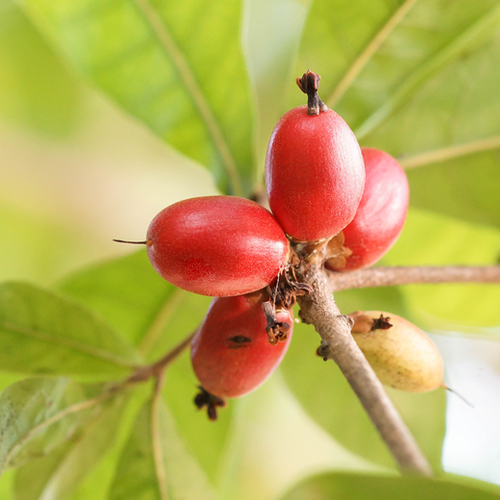
Miracle fruit
Scientific names: Synsepalum dulcificum, Bakeriella dulcifica, Bumelia dulcifica, Richadellla dulcifica, Sideroxylon dulcificum
Family: Sapotaceae
Alternate names: Agbayun, Fruit Miracle, Fruit Miraculeux, Fruta Milagrosa, Magic Berry, Miracle Berry, Miraculin, Miraculous Berry, Sweet Berry, Uni
Background
Miracle fruit is an evergreen shrub that grows in West Africa. The berry, leaf, and seed oil are used as medicine.
People use miracle fruit for diabetes, obesity, taste disturbances in people treated with cancer drugs, and other conditions, but there is no good scientific evidence to support these uses.
In foods, miracle fruit is used as a low-calorie sugar-free sweetener.
Don't confuse miracle fruit with aloe (miracle fruit), gymnema (miracle plant), and jiaogulan (miracle grass).
People use miracle fruit for diabetes, obesity, taste disturbances in people treated with cancer drugs, and other conditions, but there is no good scientific evidence to support these uses.
In foods, miracle fruit is used as a low-calorie sugar-free sweetener.
Don't confuse miracle fruit with aloe (miracle fruit), gymnema (miracle plant), and jiaogulan (miracle grass).
Safety Safety definitions
When taken by mouth: There isn't enough reliable information to know if miracle fruit is safe or what the side effects might be. Miracle fruit might cause an allergic reaction in some people.
When applied to the skin: There isn't enough reliable information to know if miracle fruit is safe or what the side effects might be. Miracle fruit might cause an allergic reaction in some people.
Allergies: People with allergies to other substances, such as peanut, latex, peach, and soy, might also be allergic to miracle fruit.
Diabetes: Miracle fruit might lower your blood sugar. As a result, your diabetes medications might need to be adjusted by your healthcare provider.
When applied to the skin: There isn't enough reliable information to know if miracle fruit is safe or what the side effects might be. Miracle fruit might cause an allergic reaction in some people.
Special Precautions & Warnings:
Pregnancy and breast-feeding: There isn't enough reliable information to know if miracle fruit is safe to use when pregnant or breast-feeding. Stay on the safe side and avoid use.Allergies: People with allergies to other substances, such as peanut, latex, peach, and soy, might also be allergic to miracle fruit.
Diabetes: Miracle fruit might lower your blood sugar. As a result, your diabetes medications might need to be adjusted by your healthcare provider.
Effectiveness
Effective Effectiveness definitions
There is interest in using miracle fruit for a number of purposes, but there isn't enough reliable information to say whether it might be helpful.
Dosing & administration
The appropriate dose of miracle fruit depends on several factors such as the user's age, health, and several other conditions. At this time there is not enough scientific information to determine an appropriate range of doses for miracle fruit. Keep in mind that natural products are not always necessarily safe and dosages can be important. Be sure to follow relevant directions on product labels and consult your pharmacist or physician or other healthcare professional before using.
Interactions with pharmaceuticals
Medications for diabetes (Antidiabetes drugs)
Interaction Rating=Moderate Be cautious with this combination.
Miracle fruit might lower blood sugar. Diabetes medications are also used to lower blood sugar. Taking miracle fruit along with diabetes medications might cause your blood sugar to go too low. Monitor your blood sugar closely. The dose of your diabetes medication might need to be changed.
Some medications used for diabetes include glimepiride (Amaryl), glyburide (DiaBeta, Glynase PresTab, Micronase), insulin, metformin (Glucophage), pioglitazone (Actos), rosiglitazone (Avandia), and others.
Interactions with herbs & supplements
Herbs and supplements that might lower blood sugar: Miracle fruit might lower blood sugar. Using miracle fruit along with other herbs and supplements that might lower blood sugar might lower blood sugar too much. Herbs that might lower blood sugar include devil's claw, fenugreek, guar gum, Panax ginseng, Siberian ginseng, and others.
Interactions with foods
There are no known interactions with foods.
Action
Miracle fruit contains a chemical that affects taste receptors in the tongue. This chemical makes the tongue register sour tastes as sweet tastes. The chemical itself has no taste at all. Miracle fruit also contains chemicals that might lower levels of blood sugar.
vital.ly has licensed monographs from TRC Healthcare.
This monograph was last reviewed on 04/07/2024 10:00:00 and last updated on 26/12/2021 05:00:48. Monographs are reviewed and/or updated multiple times per month and at least once per year.
Natural Medicines disclaims any responsibility related to medical consequences of using any medical product. Effort is made to ensure that the information contained in this monograph is accurate at the time it was published. Consumers and medical professionals who consult this monograph are cautioned that any medical or product related decision is the sole responsibility of the consumer and/or the health care professional. A legal License Agreement sets limitations on downloading, storing, or printing content from this Database. No reproduction of this monograph or any content from this Database is permitted without written permission from the publisher. It is unlawful to download, store, or distribute content from this site.




